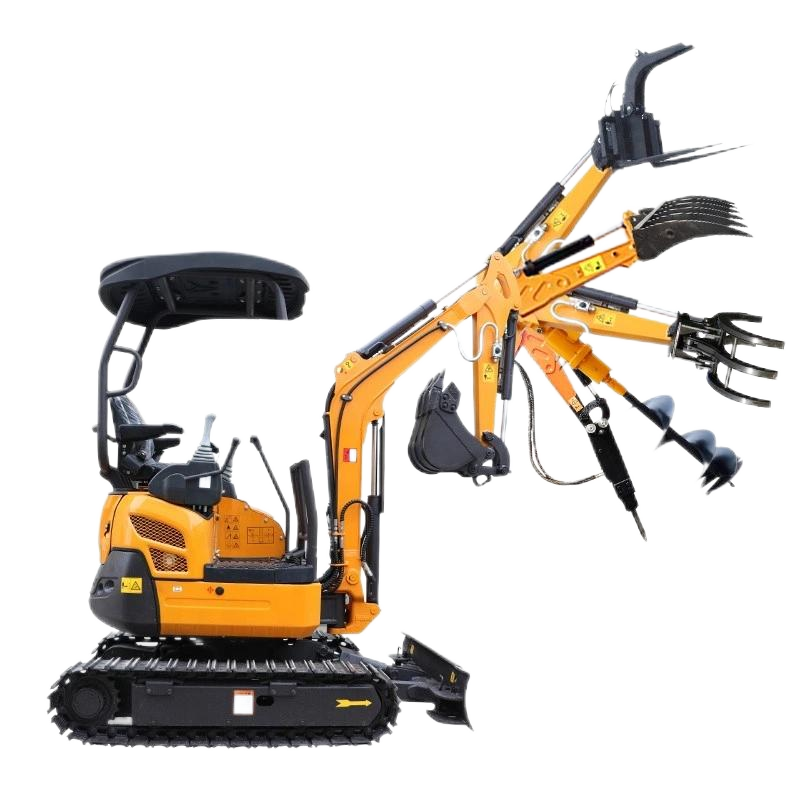As a core equipment in the field of engineering construction, the working principle of an excavator integrates multidisciplinary technologies such as mechanical transmission, hydraulic systems, and electrical control. The following details its working principle from aspects including core structure, power transmission, hydraulic system operation, and operation processes:

- Engine: Usually a diesel engine ( use electric motors), providing power for the entire machine. Diesel engines are the mainstream choice due to their high torque and adaptability to harsh working conditions.
- Power Distribution: The power output by the engine is transmitted to components such as hydraulic pumps and travel motors through the transmission system (e.g., clutches, gearboxes).
- Boom: The main structure connecting the body and the stick, realizing up-and-down pitching through the extension and retraction of hydraulic cylinders.
- Stick: Located at the front end of the boom, controlled by another set of hydraulic cylinders for extension and retraction to adjust the working radius and excavation depth.
- Bucket: The component directly performing excavation, driven by hydraulic cylinders for opening/closing and tilting. The bucket shape is designed in different types according to working conditions (e.g., earthwork, rock).
The hydraulic system is the core for excavators to achieve precise movements, based on Pascal's law (liquid pressure transmission). It mainly consists of the following parts:
- Function: Converts the mechanical energy of the engine into hydraulic energy (high-pressure oil).
- Types: Mostly piston pumps or gear pumps. Piston pumps are commonly used in large excavators due to their high efficiency and large pressure.
- Working Process: The engine drives the hydraulic pump to rotate. The pump sucks oil from the tank, forms high-pressure oil through compression, and delivers it to each hydraulic cylinder via pipelines.
- Boom Cylinder: Controls the boom's lifting. When high-pressure oil enters the rodless cavity of the cylinder, the piston pushes the boom up; when oil returns, the boom descends.
- Stick Cylinder: Controls the stick's extension/retraction, with a principle similar to the boom cylinder.
- Bucket Cylinder: Controls the bucket's tilting and unloading, achieving forward/reverse actions through bidirectional oil flow.
- Function: Regulates the flow, pressure, and direction of oil to achieve precise movement control.
- Types: Including directional valves (controlling movement direction), relief valves (limiting system pressure to prevent overload), throttle valves (adjusting flow to control movement speed), etc.
The tank stores hydraulic oil, filters impurities through filters, and cools the oil via coolers to ensure stable system operation.
- Structure: Tracked or wheeled . Tracked types are independently driven by travel motors on both sides.
- Principle: The hydraulic motor rotates after receiving high-pressure oil, driving the track sprocket through a reducer to achieve forward/backward movement or steering (steering angle is controlled by speed differences between the two tracks).
- Composition: Including a swing bearing (large gear ring) and a swing motor.
- Working Principle: The swing motor drives the pinion to rotate, driving the large gear ring (fixed to the upper carriage) to make the upper carriage (with boom, stick, etc.) achieve 360° swing for adjusting the working direction.
Responsible for engine starting, lighting, instrument display, etc. Modern excavators are also equipped with sensors (e.g., fuel consumption sensors, hydraulic oil temperature sensors) to monitor equipment status in real time.
- Function: Integrates sensor data through the ECU (Electronic Control Unit) to optimize hydraulic system pressure and flow distribution, achieving movement coordination and energy saving.
- Intelligent Technologies: Some high-end models introduce GPS positioning, automatic leveling systems, and even remote control functions to enhance operation accuracy and safety.
- Positioning and Adjustment: Move the bucket above the work point through the travel and swing systems, and lower the boom to make the bucket contact the ground.
- Excavation Movement:
- The stick cylinder extends, and the bucket cylinder tilts to make the bucket cut into soil or rock.
- The boom cylinder rises while the stick cylinder retracts to "lift" the material.
- Swing and Unloading:
- The swing motor drives the upper carriage to turn to the unloading point, and the bucket cylinder tilts to unload the material.
- Reset and Repetition: The swing platform returns to the work point, the boom descends, and enters the next cycle.
- Force Transmission and Amplification: The hydraulic system pushes the large piston (cylinder) through the small piston (pump) to achieve "small force amplification," enabling the bucket to withstand excavation forces of several to tens of tons.
- Working Condition Adaptability:
- Earthwork operations: Buckets are designed wide and shallow to reduce resistance.
- Rock operations: Bucket materials are strengthened (wear-resistant steel), hydraulic system pressure is increased, and attachments like breaker hammers are used.
The working principle of an
excavator can be summarized as: Engine provides power → Hydraulic system converts mechanical energy into hydraulic energy → Hydraulic cylinders drive working devices to perform movements → Electrical control system coordinates components for precise operation. This system not only ensures the reliability of high-intensity operations but also achieves movement flexibility through the integration of hydraulic and electronic technologies, making it an indispensable equipment in mining, construction, municipal engineering, and other fields.






